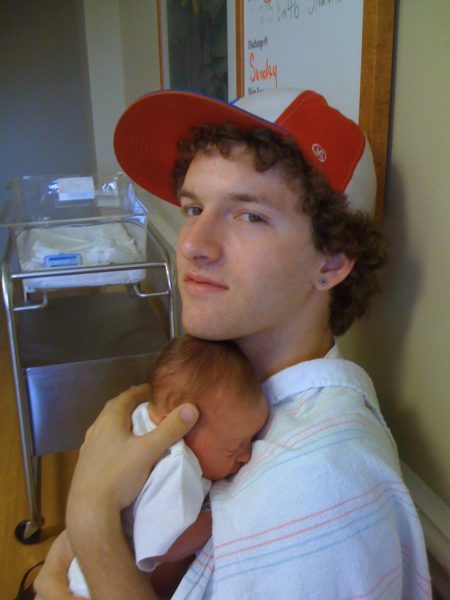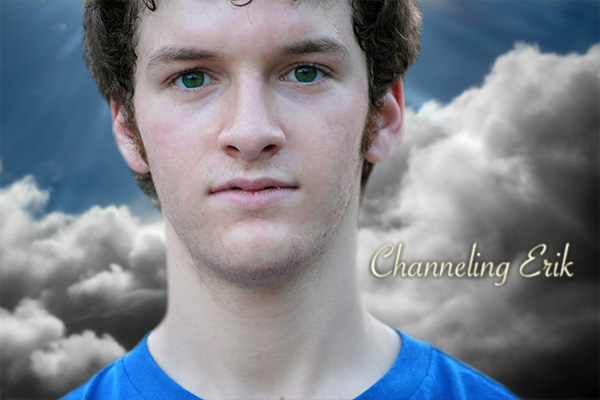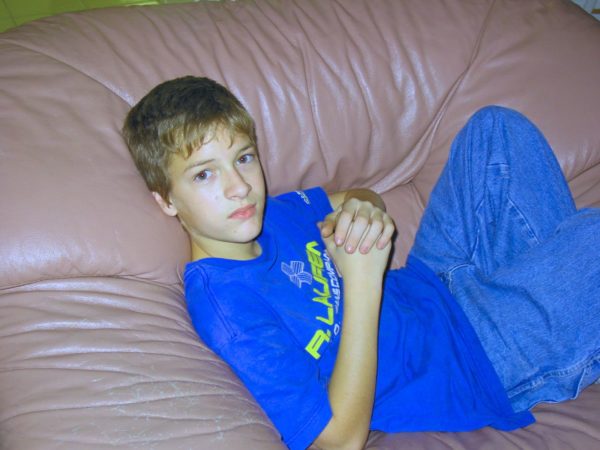Me: Is there any spiritual basis behind people not being able to connect with others or more so for people who have a fear of getting close to others—not so much in an, “Oh geez, they might find me out,” but just not being able to share their feelings? Maybe it’s about trust?
Jamie: So what it is? People who cannot—
Me: Share their feelings. A fear of getting too close to others.
(Long pause)
Jamie (chuckling): That’s cool. Um. That’s REALLY cool.
(Pause)
Jamie (to Erik): How’re you doing that?
Jamie listens to Erik.
Jamie: Have you ever been to planetarium, you know, where the whole room changes?
Me: Yeah!
Jamie: Or like a cyclorama kind of a thing where the whole movie is playing round you in a 360?
Me: Yeah!
Jamie: Erik normally will give me imagery or motion imagery or picture, and it’s commonly either in my head or right in front of me like about two feet away that I see it. But what he’s doing now is all over the room. That’s the first time I’ve ever had that.
Me: Wow, awesome!
Jamie: So, it’s like being in a mini-planetarium, and you’re talking about people who can’t open up emotionally, and he’s showing me a thick red line, probably about 6 inches thick.
Me: Mm hm.
Jamie: It’s about 12 feet off the ground, and it just goes in a complete circle around my whole office. And they’re all these markers and lines on it. They’re different lengths and widths and colors. And he’s saying there are so many variations of why people emotionally shut down, and all these little lines on this thick red band are connected to the center. And then the center, it looks like a, oh, I see like a little round ball.
Me: Wait, are the lines on the red line horizontal? How are they attached to the red line?
Jamie: Yeah, they just look like if you took a ruler horizontally and drew lines—
Me: Okay. Got it, got it.
Jamie: Kind of like a—(pause)—I don’t know. And then parallel to the floor, there’s a line that attaches to that red thick band straight to this little sphere in the middle of the room.
Me: Okay.
Jamie: And the sphere in the middle of the room, uh, he names it the basis of all the emotions—Love. And so Love radiates the same way to every little marker on this red band. That line from the center to the red band is the same for each and every person.
Me: Hm! Are the little horizontal lines—are they people?
Jamie: They’re all different. (to Erik) Are they people?
(Pause)
Erik: They represent how people translate emotion.
I can almost hear my jaw drop.
Erik: Their comfort level.
Jamie: I couldn’t even begin to count them. I don’t even, I wouldn’t even know where to start.
Erik: Emotions are three-dimensional whereas most people see them as an expression, which is almost 2-D—
Me: Okay. I can see that.
Erik—when we use that kind of word.
Jamie: It’s why he’s trying to show a 3-D image of the horizontal line having a color, a length, and a width. 3-D.
Me: Mm!
Jamie: Actually depth, width, height and a color.
Erik: And so when we’re talking to this family member—
Jamie (to Erik): You’re so cute.
Me: Huh?
Jamie: The person who wrote in.
Me: Aw, he calls his blog members family!
Erik: When we’re talking to her about this, she has to understand that the root of the cause is that the person is not connecting to Love.
(See, Lorraine? Erik knew you, a female, asked the question!)
Erik: That’s the root of it, so if you wanna go straight to the cause, no matter what the situation is, you go to the person and you ask them, “How do you experience Love or what does it feel like to you?”
Me: Mm.
Erik: You know, you get all Zen, and you try to get them to talk about it. Love from a parent, from a teacher, through a career or an experience—it’s still Love even though it comes from locations in your life. It shouldn’t be valued more or less.
(Pause)
Erik: It may come in different volumes—two scoops, one scoop—
Jamie and I can’t help but giggle.
Erik: —but the quality of it is the same. It’s Love. Then you figure out what the person’s definition of Love is. That way you can understand more how you can play a part. You can sit down for hours and ask people what they’re afraid of, but you’re, but you know what? If they’re really afraid, they’re not gonna fucking tell YOU!
Me: True!
Erik: Yeah, so don’t waste your breath on solutions. Use your breath and use your conversations for identification. Ask for more details. You know, where do you feel Love in your body? Do you like it? Did you ever want more of it? Do you feel safe when you’re loved? I think people are just at a loss, because that kind of conversation usually doesn’t happen with people, because they feel like that’s therapy shit. For everyone reading right now, that’s not therapy shit. It actually should be part of every relationship that you’re in. The whole goal of being human is to experience emotions. We’re emotional beings, and the basis for all emotion is unconditional love.
Me: Yep.
Erik: And if we can’t talk about it, then maybe we shouldn’t have the right to do it at all.
Jamie giggles.
Jamie: I’m laughing and this is why. He said, “Same about sex. If you can’t talk about fucking sex and intercourse, then maybe you shouldn’t be having it at all.”
Jamie and I laugh.
Erik: You know, that used to be such a taboo topic. Why are Love and emotions a taboo topic?
Me: I know! Seriously!
Erik: You know, is it broken? Wooooo.
Me: Now, what about the red line? What does that represent?
Jamie: That big, thick red band?
Me: Yeah. The red band.
Erik: That’s the Oneness that holds us all together.
Jaw-dropping moment.
Erik: That’s the communication. It’s the God Source, Life Force, emotions, the pureness that holds us all together. If you notice—
Jamie (giggling): I asked him, “Is this going to be a permanent fixture in my office, or is this going to go away?”
I chuckle at the thought of Jamie and her psychedelic workspace.
Jamie: Cuz that would be wild.
Erik: If you notice, some of the horizontal lines are red, and they blend in to that big, thick red band. Those are the people who can understand how to connect to other people.
Me: Oh! So—
Jamie starts to talk.
Me: Oh, go ahead.
Jamie: So, he was talking about the other colors. They’re representations of how people cannot communicate emotions—how they use the energy coming through them and to them and manipulate it. And it sours the color. It sours the purity of it. That’s why they’ve changed colors. And then some people hold on too much. That’s why it’s changing shape.
Erik: Some people just give too much shit away, and that also changes the shape. That would be too thin. The other one holding on makes the line more fat or longer.
Me: But do they all connect to the sphere?
Erik: Yeah, yeah! They’re all on the big red band that creates that circle, and then every horizontal line has a line coming from its center like at a belly button, all the way in to the sphere that’s in the middle of the room. Like a bicycle wheel with a whole ton of spokes.
Me: Are any of them black?
Jamie: Huh?
Me: Are any of the bands black?
Erik: The horizontal ones?
Me: Yeah.
Erik: Yeah.
Me: And what does that mean?
Erik: Assholes. Dickheads.
Jamie laughs.
Me: Oh no! What is that, the absence of light? So, the darker the color means the less light they have?
Erik: No, it’s a person who won’t acknowledge acceptance, who won’t accept what’s given or fed or what’s around him.
Me: What about the brighter colors like bright yellow and white.
Long pause, then Jamie giggles.
Erik: Do you wanna go through this? There’s like a thousand shades.
Me: Okay, well does it really correspond to the color chart, to the, you know, chakra colors and all that stuff?
Erik: Oh, yeah, but the chakra colors, they’re just seven small pinpoints on the whole light spectrum. It’s kind of ridiculous to—
Me: Well, I don’t want to be ridiculous!
Erik (laughing): It’s kind of ridiculous to have only seven, because there are so many other hues.
Me: Okay. Well, I don’t want to go through millions and millions of them! This is all very interesting, Erik!
Jamie: It is really cool!
Me: Anything else on this? It’s so amazing all you’ve said, so I can’t imagine that they’d be anything else, but I’d hate to leave you hanging!
Erik: uh uh.
Me: Okay. Well done, Erik!



